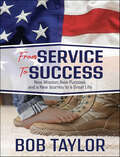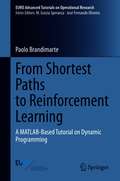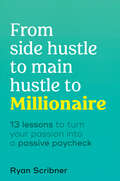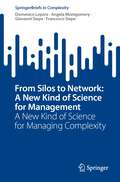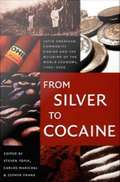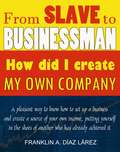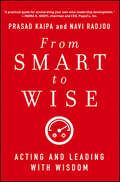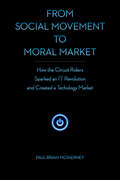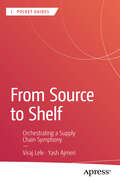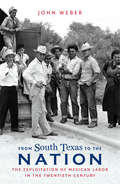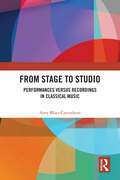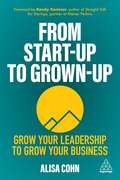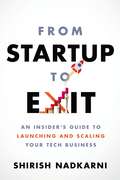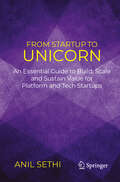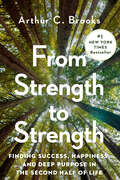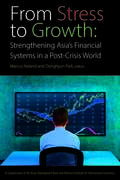- Table View
- List View
From Service To Success: New Mission, New Purpose, and a New Journey to a Great Life
by Bob TaylorMore veterans died from suicide in a ten-year period than during the entirety of the Vietnam War There is a very large problem in our veteran community. Every day, 640 veterans attempt suicide, 22 veterans die, and over 5,500 are thinking about committing suicide. Approximately 48% of all military members struggle after transitioning from military service—but these struggles don’t have to be the end of their story. There is a bright and successful future available for every veteran if we can help them reach their greatest potential.From Service to Success is a lifeline for veterans who seek to move past the pain and trauma of service and adapt to a new way of living. A veteran himself, Bob Taylor shares his experiences and the stories of others to remind readers that they are not alone. According to Bob, “We need to find forgiveness for ourselves, find a new purpose, learn new tools and skills, and press forward so we don't spend the rest of our lives in the darkness.”In From Service to Success, Bob Taylor explains that while it's very important for veterans to have the means to support themselves, it is absolutely critical that they learn ways to become a part of their community, to forgive themselves, to develop healthy living styles, and to grab onto the best that life has to offer. The three most important steps for veterans to take after reading From Service to Success:Create a mindset of gratitudeFind a way to sleep through the night—if necessary, seek help to get thereDiscover a purpose bigger than themselves
From Shortest Paths to Reinforcement Learning: A MATLAB-Based Tutorial on Dynamic Programming (EURO Advanced Tutorials on Operational Research)
by Paolo BrandimarteDynamic programming (DP) has a relevant history as a powerful and flexible optimization principle, but has a bad reputation as a computationally impractical tool. This book fills a gap between the statement of DP principles and their actual software implementation. Using MATLAB throughout, this tutorial gently gets the reader acquainted with DP and its potential applications, offering the possibility of actual experimentation and hands-on experience. The book assumes basic familiarity with probability and optimization, and is suitable to both practitioners and graduate students in engineering, applied mathematics, management, finance and economics.
From Side Hustle to Main Hustle to Millionaire: 13 Lessons to Turn Your Passion Into a Passive Paycheck
by Ryan ScribnerYour side hustle is waiting—get started! Anyone with the desire can start a side hustle, and there are more opportunities now than ever before. In 2017, YouTube personality and personal finance guru Ryan Scribner quit his day job to focus exclusively on his side hustle. By 2021, at the age of 26, he had become a millionaire. From Side Hustle to Main Hustle to Millionaire tells Ryan&’s story of transitioning from the 9-to-5 grind to a liberating and lucrative career as a self-employed business owner—and gives you the tools to launch a side hustle too. In 13 simple lessons, Ryan shares what it takes to leave the workforce behind, follow your passions, and earn passive income. Learn how to build a successful side business that you can grow to your main source of income over time, with specific guidance on each step of the process, including: How to embrace frugality and set yourself up for financial successWhat to consider when choosing a side hustle—with suggestions for identifying untapped marketsWhy a good mentor is important—and how to find oneStrategic steps to grow your audience or customer baseWhen and how to diversify into other assets and create passive revenue streams
From Silk to Silicon: The Story of Globalization Through Ten Extraordinary Lives
by Jeffrey E. GartenStories of ten historical figures who helped build the long road to globalization, from Genghis Khan to an Intel CEO: “Filled with brilliant vignettes.” —The Washington PostThis is the story of globalization, the most powerful force in history, as told through the lives and times of ten people who established new connections between people and nations—whether that was their primary goal or not. Rather than focusing on trends, policies, or particular industries, From Silk to Silicon views the topic of globalization for the first time through the lens of individuals and their transformative actions. It tells us who these men and women were, what they did, how they did it, and how their achievements continue to shape our world today. You’ll read about Genghis Khan, who united east and west by conquest and by opening new trade routes built on groundbreaking transportation, communications, and management innovations; Mayer Amschel Rothschild, who escaped the ghetto and ushered in an era of global finance; Cyrus Field, who led the effort to build the transatlantic telegraph; Margaret Thatcher, whose controversial policies opened the gusher of substantially free markets that linked economies across borders; Andy Grove, a Hungarian Holocaust survivor who, at Intel, laid the foundation for Silicon Valley’s computer revolution; and more.Economist Jeffrey E. Garten finds the common links between these figures and probes critical questions including: How much influence can any one person have in fundamentally changing the world? How have past trends in globalization affected the present? And how will they shape the future? “Fascinating and illuminating.” —Fareed Zakaria, author of Age of Revolutions“Garten has brilliantly updated Thomas Carlyle’s Great Man theory of history . . . A tour de force, imaginative, informative and just plain fun to read.” —Strobe Talbott, former Deputy Secretary of State“A terrific book on globalization . . . really compelling.” —Thomas L. Friedman, author of The World is Flat
From Silos to Network: A New Kind of Science for Managing Complexity (SpringerBriefs in Complexity)
by Domenico Lepore Angela Montgomery Giovanni Siepe Francesco SiepeThis book provides the conceptual framework and a comprehensive guide to the principles, methods and tools for managing organizations. The authors introduce “New Knowledge” by presenting a methodology, 'The Decalogue’, that portrays a genuinely systemic approach for managing complexity in organizations and Value Chains through focusing on the management of a leverage point called constraint (Theory of Constraints) and the understanding of variation (Theory of Profound Knowledge). This systemic approach leverages the intrinsic process and project-based nature of the work of organizations. Functional hierarchy is replaced by a network-like structure, driven by the goal of the system and governed by a new design of the organization called “Network of Projects”. The transition towards the Network of Projects requires a cognitive shift in the way we view and put to good use human talent and ingenuity as well as a powerful algorithm to orchestrate and synchronize individual competencies.The authors discuss at length this algorithm, how the Theory of Constraints helps in the cognitive challenges of this shift and also how technology can be used fruitfully to assist with the operational implications. The target audience for this book is made up of leaders and managers of organizations as well as researchers and practitioners in the field of management and organizational design.
From Silver to Cocaine: Latin American Commodity Chains and the Building of the World Economy, 1500-2000
by Steven Topik Carlos Marichal Zephyr FrankDemonstrating that globalization is a centuries-old phenomenon, From Silver to Cocaine examines the commodity chains that have connected producers in Latin America with consumers around the world for five hundred years. In clear, accessible essays, historians from Latin America, England, and the United States trace the paths of many of Latin America's most important exports: coffee, bananas, rubber, sugar, tobacco, silver, henequen (fiber), fertilizers, cacao, cocaine, indigo, and cochineal (insects used to make dye). Each contributor follows a specific commodity from its inception, through its development and transport, to its final destination in the hands of consumers. The essays are arranged in chronological order, according to when the production of a particular commodity became significant to Latin America's economy. Some--such as silver, sugar, and tobacco--were actively produced and traded in the sixteenth century; others--such as bananas and rubber--only at the end of the nineteenth century; and cocaine only in the twentieth. By focusing on changing patterns of production and consumption over time, the contributors reconstruct complex webs of relationships and economic processes, highlighting Latin America's central and interactive place in the world economy. They show how changes in coffee consumption habits, clothing fashions, drug usage, or tire technologies in Europe, Asia, and the Americas reverberate through Latin American commodity chains in profound ways. The social and economic outcomes of the continent's export experience have been mixed. By analyzing the dynamics of a wide range of commodities over a five-hundred-year period, From Silver to Cocaine highlights this diversity at the same time that it provides a basis for comparison and points to new ways of doing global history. Contributors. Marcelo Bucheli, Horacio Crespo, Zephyr Frank, Paul Gootenberg, Robert Greenhill, Mary Ann Mahony, Carlos Marichal, David McCreery, Rory Miller, Aldo Musacchio, Laura Nater, Ian Read, Mario Samper, Steven Topik, Allen Wells
From Slave to Businessman: How did I create my own company
by Franklin A. Díaz LárezThis is the narration of the journey of a desperate man, who is in search of solutions to his multiple economic problems. <P><P> After a long process of self-critical reflection, he decides to leave his job to create his own company. And he succeeds, not without first overcoming dozens of obstacles, setbacks and stumbling blocks. <P><P> A book written in the form of entertaining and, at times, with funny stories, which describes the steps to follow in the world of entrepreneurship, based on the experiences of its protagonist. <P><P> Away from didactic, rigid or academic descriptions, it tells a peculiar story in which its main character is overcoming important and implacable obstacles, until finally arriving at the long-awaited financial independence. <P><P> A pleasant way to know how to set up a business and create a source of your own income, putting yourself in the shoes of another who has already achieved it. <P><P> This book is dedicated to those who wish to definitely liberate themselves from the yoke of the modern forms of labor slavery of our time, and from the cruel and dramatic uncertainty of unemployment.
From Slavery to Aid
by Benedetta RossiFrom Slavery to Aid engages two major themes in African historiography, the slow death of slavery and the evolution of international development, and reveals their interrelation in the social history of the region of Ader in the Nigerien Sahel. Benedetta Rossi traces the historical transformations that turned a society where slavery was a fundamental institution into one governed by the goals and methods of 'aid'. Over an impressive sweep of time - from the pre-colonial power of the Caliphate of Sokoto to the aid-driven governments of the present - this study explores the problem that has remained the central conundrum throughout Ader's history: how workers could meet subsistence needs and employers fulfil recruitment requirements in an area where natural resources are constantly exposed to the climatic hazards characteristic of the edge of the Sahara.
From Smart to Wise: Acting and Leading with Wisdom
by Navi Radjou Prasad KaipaA fresh and timely approach to nurturing wise, resilient, and flexible leadership in a world of growing complexity Leaders tend to obstinately stick to the leadership style that brought them most success in the past, usually one of two extreme styles: functional leadership that focuses on operational excellence or smart leadership that focuses on growth. When a leader's focus is too functional, the organization becomes introverted and can focus too much on bottom-line profitability while missing out on top-line growth opportunities. But when leaders focus too much on smart leadership, the organization may experience quick growth but lose its effectiveness quickly. From Smart to Wise offers a new approach that balances the two styles to achieve a form of wise leadership that is both functional and smart. Drawing on inspiring real-life stories of historical and contemporary wise leaders such as Bill Gates, Warren Buffet, and even Mahatma Gandhi, the authors identify six characteristics of wise leaders and offer a practical framework to help readers develop their own style of wise leadership. A timely and innovative approach to leadership Written by noted speakers who conduct dozens of keynote speeches and workshops, training thousands of people annually
From Social Movement to Moral Market: How the Circuit Riders Sparked an IT Revolution and Created A Technology Market
by Paul-Brian McinerneyIn From Social Movement to Moral Market, Paul-Brian McInerney explores what happens when a movement of activists gives way to a market for entrepreneurs. This book explains the transition by tracing the brief and colorful history of the Circuit Riders, a group of activists who sought to lead nonprofits across the digital divide. In a single decade, this movement spawned a market for technology assistance providers, dedicated to serving nonprofit organizations. In contrast to the Circuit Riders' grassroots approach, which was rooted in their commitment to a cause, these consultancies sprung up as social enterprises, blending the values of the nonprofit sector with the economic principles of for-profit businesses. Through a historical-institutional analysis, this narrative shows how the values of a movement remain intact even as entrepreneurs displace activists. While the Circuit Riders serve as a rich core example in the book, McInerney's findings speak to similar processes in other "moral markets," such as organic food, exploring how the evolution from movement to market impacts activists and enterprises alike.
From Source to Shelf: Orchestrating a Supply Chain Symphony (Apress Pocket Guides)
by Viraj Lele Yash AjmeriIn today's global market, supply chain management has become more critical than ever. This book delves into the strategic, operational, and technological aspects of supply chains, offering insights and practical solutions to create a seamless and resilient supply network. The main topics covered are production planning and inventory control, logistics and distribution, sustainability, risk management and future trends. Companies are facing unprecedented challenges, from geopolitical uncertainties and trade wars to natural disasters and global pandemics. These disruptions can have significant impacts on the supply chain, leading to delays, increased costs, and loss of customer trust. By addressing these critical areas, this book aims to equip you with the knowledge and tools needed to optimize your supply chains, drive innovation, and achieve sustainable success in a dynamic and challenging environment. Whether you are a seasoned supply chain professional or a newcomer to the field, From Source to Shelf provides valuable insights and practical guidance to help you master the art of supply chain management. What You Will Learn Understand the fundamental components and functions of supply chain management. Develop and implement effective supply chain strategies that align with overall business objectives. Navigate the complexities of modern supply chain management. Leverage cutting-edge technologies and implement sustainable and resilient practices. Who This Book is For Supply Chain professionals, managers, and consultants.
From South Texas to the Nation: The Exploitation of Mexican Labor in the Twentieth Century (The David J. Weber Series in the New Borderlands History)
by John WeberIn the early years of the twentieth century, newcomer farmers and migrant Mexicans forged a new world in South Texas. In just a decade, this vast region, previously considered too isolated and desolate for large-scale agriculture, became one of the United States' most lucrative farming regions and one of its worst places to work. By encouraging mass migration from Mexico, paying low wages, selectively enforcing immigration restrictions, toppling older political arrangements, and periodically immobilizing the workforce, growers created a system of labor controls unique in its levels of exploitation.Ethnic Mexican residents of South Texas fought back by organizing and by leaving, migrating to destinations around the United States where employers eagerly hired them--and continued to exploit them. In From South Texas to the Nation, John Weber reinterprets the United States' record on human and labor rights. This important book illuminates the way in which South Texas pioneered the low-wage, insecure, migration-dependent labor system on which so many industries continue to depend.
From Stage to Studio: Performances versus Recordings in Classical Music (Routledge Research in Music)
by Amy Blier-CarruthersFrom Stage to Studio: Performances versus Recordings in Classical Music presents a cultural study of classical music-making through the analysis of live and studio performances of orchestral and operatic repertoire conducted by Sir Charles Mackerras.The close listening analysis is based on detailed research into Mackerras’s private collection of over 600 reel-to-reel and cassette tapes containing recordings of over 1,000 live performances which he conducted between the 1950s and the late 1990s. This is contextualized with evidence collected during ethnographic fieldwork observations, presenting the opinions of Sir Charles, orchestral musicians from major London orchestras and opera houses with whom he was working with during the first decade of the twenty-first century (Philharmonia, Orchestra of the Age of Enlightenment, Royal Opera House, English National Opera), and production team members working for recording industry leaders (such as Decca, EMI, and Chandos). This ethnography of classical music-making gives a voice to performers and music professionals, brings to light some important and heretofore hidden issues, and explores a fascinating time of intense change in the recording industry.Including consideration of ways forward for performance, education, and recording, this book is relevant to specialist practitioners, as well as music enthusiasts interested in concert life and recording studio habits, professional performers, recordists, music students, educators, and scholars interested in classical music.
From Start-Up to Grown-Up Nation: The Future of the Israeli Innovation Ecosystem
by Elie Ofek Margot EiranIn June 2016, Benjamin (Bibi) Netanyahu, Prime Minister of Israel, wrestled with how to sustain Israel's strong innovation track record and the country's reputation as the 'startup nation.' Despite the economic miracle the country had wrought since its founding, he knew he could not be complacent. On the one hand, in 2015 Israeli start-ups raised record-breaking amounts of venture capital, and exits for the year totaled over $8 Billion. On the other hand, government expenditure on R&D had decreased and Israel's position in the Global Innovation Index had fallen. Several other indicators, such as achievement tests among elementary school students in math and science, painted a grim picture. Furthermore, in spite of the wealth created by many high-tech Israeli firms, socioeconomic gaps in the country had widened. A two-tier economy had formed. The long-term sustainability of the "innovation economy" was in doubt, as the sector faced increased competition from foreign innovation hubs, was being reshaped by the growth of Multinational Corporations (MNCs) locating R&D centers in Israel, and had to contend with a vexing shortage of human capital and low labor force participation among some groups. Netanyahu had to assess whether it was time to sound the alarm, and whether drastic and immediate measures were needed to right the innovation economy ship. Bibi mulled over which policies or interventions would best curb the erosion of Israel's competitive position as an innovation powerhouse and how best to promote social equality. He pondered whether public policy could make a difference or whether the market and societal currents, responsible for these trends, were too strong for him and his government to try to contend with.
From Start-Up to Grown-Up Nation: The Future of the Israeli Innovation Ecosystem
by Elie Ofek Margot EiranIn June 2016, Benjamin (Bibi) Netanyahu, Prime Minister of Israel, wrestled with how to sustain Israel's strong innovation track record and the country's reputation as the 'startup nation.' Despite the economic miracle the country had wrought since its founding, he knew he could not be complacent. On the one hand, in 2015 Israeli start-ups raised record-breaking amounts of venture capital, and exits for the year totaled over $8 Billion. On the other hand, government expenditure on R&D had decreased and Israel's position in the Global Innovation Index had fallen. Several other indicators, such as achievement tests among elementary school students in math and science, painted a grim picture. Furthermore, in spite of the wealth created by many high-tech Israeli firms, socioeconomic gaps in the country had widened. A two-tier economy had formed. The long-term sustainability of the "innovation economy" was in doubt, as the sector faced increased competition from foreign innovation hubs, was being reshaped by the growth of Multinational Corporations (MNCs) locating R&D centers in Israel, and had to contend with a vexing shortage of human capital and low labor force participation among some groups. Netanyahu had to assess whether it was time to sound the alarm, and whether drastic and immediate measures were needed to right the innovation economy ship. Bibi mulled over which policies or interventions would best curb the erosion of Israel's competitive position as an innovation powerhouse and how best to promote social equality. He pondered whether public policy could make a difference or whether the market and societal currents, responsible for these trends, were too strong for him and his government to try to contend with.
From Start-Up to Grown-Up Nation: The Future of the Israeli Innovation Ecosystem (Abridged)
by Elie Ofek Margot EiranCase
From Start-Up to Grown-Up Nation: The Future of the Israeli Innovation Ecosystem (Abridged)
by Elie Ofek Margot EiranIn June 2016, Benjamin (Bibi) Netanyahu, Prime Minister of Israel, wrestled with how to sustain Israel's strong innovation track record and the country's reputation as the "start-up nation." Despite the economic miracle the country had wrought since its founding, he knew he could not be complacent. On the one hand, in 2015 Israeli start-ups raised record-breaking amounts of venture capital, and exits for the year totaled over $8 billion. On the other hand, government expenditure on R&D had decreased and Israel's position in the Global Innovation Index had fallen. Several other indicators, such as achievement tests among elementary school students in math and science, painted a grim picture. Furthermore, in spite of the wealth created by many high-tech Israeli firms, socioeconomic gaps in the country had widened. A two-tier economy had formed. The long-term sustainability of the "innovation economy" was in doubt, as the sector faced increased competition from foreign innovation hubs, was being reshaped by the growth of Multinational Corporations (MNCs) locating R&D centers in Israel, and had to contend with a vexing shortage of human capital and low labor force participation among some groups. Netanyahu had to assess whether it was time to sound the alarm, and whether drastic and immediate measures were needed to right the innovation economy ship. Bibi mulled over which policies or interventions would best curb the erosion of Israel's competitive position as an innovation powerhouse and how best to promote social equality. He pondered whether public policy could make a difference or whether the market and societal currents, responsible for these trends, were too strong for him and his government to try to contend with.
From Start-Up to Grown-Up: Grow Your Leadership to Grow Your Business
by Alisa CohnEvery start-up founder feels overwhelmed and uncertain at various times. The key to managing the relentless turmoil of a start-up is learning to manage yourself. From Start-Up to Grown-Up gives you, the founder and CEO of a great start-up, the knowledge and experience that executive coach Alisa Cohn has gained from helping companies such as Etsy, Foursquare, InVision and The Wirecutter become headline names. Growth of your company begins with growth within you. The book provides you with effective and practical ways of maximizing your strengths, defusing your triggers, controlling your self-doubt and building on your motivators. With these self-management tools, you can then turn your attention to managing your team by ensuring the flow of communication and finding the joy of delegation and the soul in meetings. Finally, you gain practical tools for managing the company and ensuring overall effectiveness of your team and strategy, using specific scripts you need to have delicate or difficult conversations.Filled with stories drawn from the author's experience, From Start-Up to Grown-Up helps you build a company with a set of core values that everybody lives by and where everyone shares a vision of where the company is going and how to get there.
From Startup to Exit: An Insider's Guide to Launching and Scaling Your Tech Business
by Shirish NadkarniTech entrepreneurs, make your startup dreams come true by utilizing this invaluable, founder-to-founder guide to successfully navigating all phases of the tech startup journey.With the advent of the internet, mobile computing, and now AI/Machine learning and cloud computing, the number of new startups has accelerated over the last decade across tech centers in Silicon Valley, Israel, India, and China. From Startup to Exit shares the knowledge that pioneering, serial entrepreneur Shirish Nadkarni has gained from over two decades of success, detailing the practical aspects of startup formation from founding, funding, management, and finding an exit. With successful tech entrepreneurs interviewed and featured throughout, From Startup to Exit will help you:Understand exactly what tech startups must do to succeed in all phases, from idea stage to IPO.Gain invaluable insights from the journeys of other successful tech founders that can be applied to your own situation.Learn how to raise millions of dollars of funding from angels and VCs to give your company the fuel it needs to take off and succeed.
From Startup to Unicorn: An Essential Guide to Build, Scale and Sustain Value for Platform and Tech Startups
by Anil SethiIf you're looking for a comprehensive guide to help make your startup successful, this book is a must-read. It covers the unique challenges of technology and platform-driven entrepreneurship, providing entrepreneurs with the tools they need to sustain growth and relevance.Technology startups face the risk of failure even after finding a product-market fit. This is due to limitations in scaling. Platform-driven startups can scale rapidly. However, they carry a high risk of failure. This book helps entrepreneurs identify the factors that can sustain technology startup growth, make early decisions, and limit risk. It also offers guidance to platform startups to mitigate the risk of failure. Featuring examples of successful startups as well as others that failed, the book offers a holistic view of entrepreneurship that highlights its importance to the broader ecosystem.This book is ideal for entrepreneurs who want to take their startup to the next level and sustain its growth. With a focus on inclusive entrepreneurship and sustaining competitive advantage, it is equally relevant for family-run companies that prioritise sustained value over generations. If you want to succeed in today's highly competitive startup landscape, this book is a valuable resource.
From Statistics to Mathematical Finance
by Wenceslao González Manteiga Dietmar Ferger Thorsten Schmidt Jane-Ling WangThis book, dedicated to Winfried Stute on the occasion of his 70th birthday, presents a unique collection of contributions by leading experts in statistics, stochastic processes, mathematical finance and insurance. The individual chapters cover a wide variety of topics ranging from nonparametric estimation, regression modelling and asymptotic bounds for estimators, to shot-noise processes in finance, option pricing and volatility modelling. The book also features review articles, e. g. on survival analysis.
From Stimulus to Consolidation: Revenue and Expenditure Policies in Advanced and Emerging Economies
by Benedict Clements Victoria Perry Juan ToroA staff team of the International Monetary Fund's Fiscal Affairs Department offers member countries a strategy for fiscal adjustment that can help support sustainable growth over the longer term. On the spending side, they suggest stabilizing pension and public health spending ratios to gross domestic product and reducing other outlays such as public wages, untargeted social spending, and subsidies. On the revenue side, they suggest reducing existing distortions in the tax system. There is no index. Annotation ©2011 Book News, Inc. , Portland, OR (booknews. com)
From Strategy to Implementation: Seeking Alignment
by Harvard Business Review PressUnlike strategy creation, which is entrepreneurial and market oriented, implementation is operations oriented and requires continuous managerial attention at all levels. This chapter uses a six-prong approach to strategic implementation and provides the tools required for evaluating how well aligned your company is with its chosen strategy.
From Strength to Strength: Finding Success, Happiness, and Deep Purpose in the Second Half of Life
by Arthur C. BrooksThe roadmap for finding purpose, meaning, and success as we age, from bestselling author, Harvard professor, and the Atlantic's happiness columnist Arthur Brooks. <p><p> Many of us assume that the more successful we are, the less susceptible we become to the sense of professional and social irrelevance that often accompanies aging. But the truth is, the greater our achievements and our attachment to them, the more we notice our decline, and the more painful it is when it occurs. <p><p> What can we do, starting now, to make our older years a time of happiness, purpose, and yes, success? <p><p> At the height of his career at the age of 50, Arthur Brooks embarked on a seven-year journey to discover how to transform his future from one of disappointment over waning abilities into an opportunity for progress. From Strength to Strength is the result, a practical roadmap for the rest of your life. <p><p> Drawing on social science, philosophy, biography, theology, and eastern wisdom, as well as dozens of interviews with everyday men and women, Brooks shows us that true life success is well within our reach. By refocusing on certain priorities and habits that anyone can learn, such as deep wisdom, detachment from empty rewards, connection and service to others, and spiritual progress, we can set ourselves up for increased happiness. <p><p> Read this book and you, too, can go from strength to strength. <p> <b>New York Times Bestseller</b>
From Stress To Growth: Strengthening Asia's Financial Systems in a Post-Crisis World
by Marcus Noland Donghyun ParkAsian financial systems, which serve the most economically dynamic region of the world, survived the global economic crisis of the last several years. In From Stress to Growth: Strengthening Asia's Financial Systems in a Post-Crisis World, scholars affiliated with the Peterson Institute for International Economics and the Asian Development Bank argue in separate essays that Asian systems must strengthen their quality, diversity, and resilience to future shocks in order to deliver growth in coming years. The book examines such phenomena as the dominance of state-owned banks, the growth of nonbank lending (the so-called shadow banks), and the need to develop local bond markets, new financial centers, and stronger supervisory tools to prevent dangerous real estate asset bubbles. China's large financial system is discussed at length, with emphasis on concerns that China's system has grown too fast, that it is overly tilted toward corporate borrowing, and that state domination has led to overly easy credit to state-owned actors. Asia needs investment to improve its infrastructure and carry out technological innovation, but the book argues that the region's financial systems face challenges in meeting that need.
